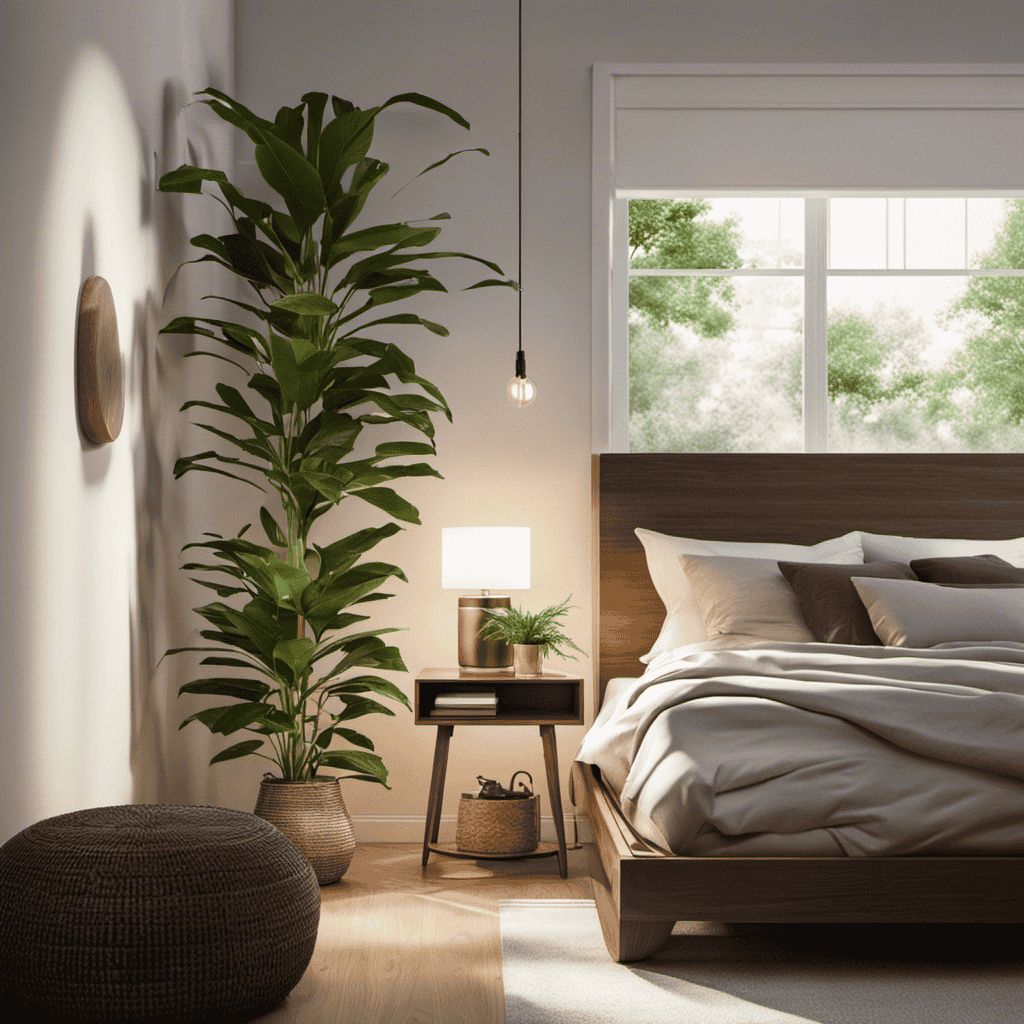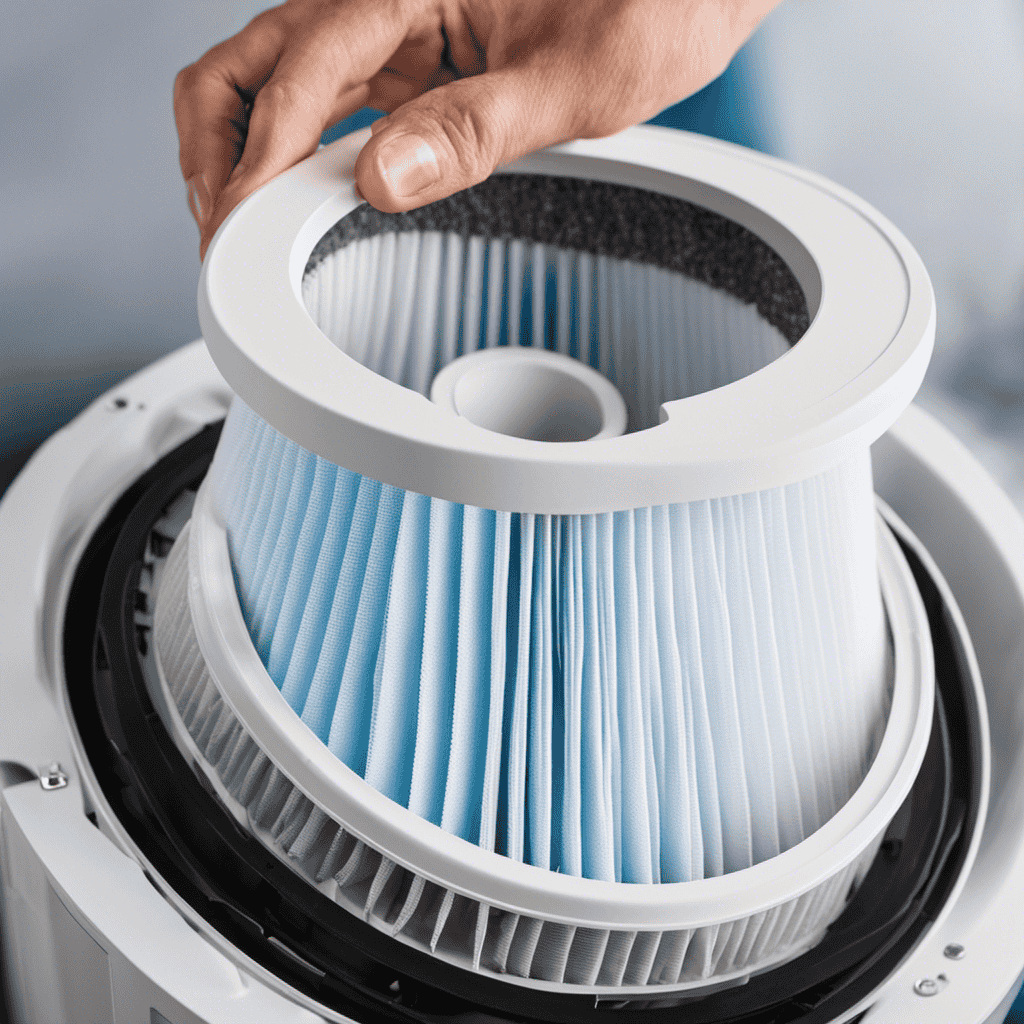As someone with a keen interest in air purifiers, I’ve frequently pondered the actual effectiveness of these machines. Following comprehensive study and evaluation, I am assured in saying that air purifiers extend beyond being mere sophisticated devices.
They have the power to remove various airborne contaminants, such as dust, allergens, pollen, pet dander, mold spores, smoke, odors, bacteria, viruses, and volatile organic compounds (VOCs).
In this article, we will delve into the fascinating world of air purifiers and explore the impressive array of pollutants they can effectively eliminate from the air we breathe.
Key Takeaways
- Air purifiers can remove dust, allergens, pollen, pet dander, mold spores, smoke, odors, bacteria, viruses, and volatile organic compounds (VOCs).
- Air purifiers with HEPA filters effectively capture dust mites and their waste particles, improving respiratory health.
- Improved removal of pollen and pet dander leads to better indoor air quality.
- Air purifiers play a crucial role in improving ventilation and reducing indoor air pollution by effectively removing pollutants such as dust, pollen, pet dander, and smoke particles.
Dust and Allergens
An air purifier can help remove dust and allergens from the air, making it easier to breathe.
Dust mites, which are microscopic pests that live in household dust, can trigger allergies and worsen respiratory health. These tiny creatures produce waste products that can cause sneezing, coughing, and difficulty breathing, especially for individuals with respiratory conditions like asthma.
Studies have shown that air purifiers equipped with HEPA filters are effective in capturing dust mites and their waste particles, reducing their presence in the air.
By removing these allergens, air purifiers can provide relief to those suffering from allergies or respiratory issues.
Investing in an air purifier can significantly improve indoor air quality and contribute to better respiratory health.
Pollen and Pet Dander
When it comes to allergen filtration effectiveness, it is crucial to consider the specific needs of individuals with allergies or sensitivities.
By utilizing an air purifier with a HEPA filter, the removal of airborne allergens such as pollen and pet dander can be significantly improved.
This leads to a remarkable improvement in indoor air quality, providing a clean and safe environment for those affected by allergies.
Allergen Filtration Effectiveness
You can easily determine the allergen filtration effectiveness of an air purifier by checking its CADR rating. CADR stands for Clean Air Delivery Rate and it measures how efficiently an air purifier can remove allergens from the air. The higher the CADR rating, the more effective the air purifier is at removing allergens such as pollen, pet dander, and dust mites. To give you an idea of what CADR ratings mean, here’s a table comparing different air purifiers:
| Air Purifier Brand | CADR Rating for Pollen (CFM) | CADR Rating for Dust (CFM) |
|---|---|---|
| Brand A | 250 | 200 |
| Brand B | 300 | 250 |
| Brand C | 350 | 300 |
| Brand D | 400 | 350 |
As you can see, Brand D has the highest CADR ratings, indicating that it is the most effective in removing allergens from the air. It’s important to regularly maintain your air purifier to ensure its effectiveness. This includes cleaning or replacing filters as recommended by the manufacturer. By investing in an air purifier with a high CADR rating and properly maintaining it, you can greatly improve the quality of air in your home or office.
Indoor Air Quality Improvement
To improve the quality of the air in your home or office, it’s essential to regularly maintain and clean the filters of your air purifier. Air purifiers play a crucial role in improving ventilation and reducing indoor air pollution.
They effectively remove various air pollutants, such as dust, pollen, pet dander, and smoke particles. These pollutants are commonly found in indoor spaces and can have detrimental effects on our health. By capturing and trapping these particles, air purifiers help to create a cleaner and healthier environment.
It is important to note that air purifiers alone cannot eliminate all air pollution sources. It is recommended to also address the root causes of indoor air pollution, such as ventilation issues and the presence of mold spores.
Transitioning to the next section, mold spores can be a significant contributor to indoor air pollution if not properly addressed.
Mold Spores
When it comes to airborne health risks, mold spores are a significant concern. These tiny particles can cause a range of health issues, including allergies, respiratory problems, and even infections in some cases.
Therefore, it is crucial to implement effective mold prevention strategies to minimize the exposure to these harmful spores and maintain a healthy indoor environment.
Airborne Health Risks
Air purifiers can help reduce the presence of airborne health risks such as allergens and pollutants. These devices are equipped with filters that can capture and remove harmful particles from the air, improving indoor air quality and reducing the risk of respiratory diseases.
Here are three ways air purifiers can be beneficial for your health:
-
Reducing air pollution: Air purifiers can effectively remove pollutants such as smoke, dust, and volatile organic compounds (VOCs) from the air, providing cleaner and healthier indoor environments.
-
Removing allergens: Air purifiers can trap common allergens like pollen, pet dander, and mold spores, helping to alleviate symptoms of allergies and asthma.
-
Neutralizing harmful gases: Air purifiers with activated carbon filters can absorb and neutralize harmful gases like formaldehyde and ozone, which can be present in indoor environments and are linked to respiratory issues.
Investing in an air purifier can be a proactive step towards safeguarding your respiratory health and creating a healthier living space.
Effective Mold Prevention
Investing in an air purifier can greatly reduce the presence of mold spores and help prevent mold growth in your home. Mold prevention techniques are essential for maintaining a healthy indoor environment.
Mold spores are microscopic particles that can easily float in the air and settle on surfaces, leading to mold growth and potential health issues. An air purifier with a high-efficiency particulate air (HEPA) filter is effective in removing mold spores from the air. HEPA filters can trap up to 99.97% of particles as small as 0.3 microns, including mold spores.
Smoke and Odors
If you’re dealing with smoke or odors, an air purifier can help eliminate them from your indoor environment. Air purifiers are designed to capture and filter out particles and pollutants in the air, providing cleaner and fresher air to breathe.
When it comes to smoke removal and odor elimination, air purifiers are highly effective. Here are three reasons why:
-
Advanced Filtration Technology: Air purifiers utilize high-efficiency filters that can trap smoke particles and odor molecules, removing them from the air you breathe. This technology ensures that even the smallest particles and odors are captured and eliminated.
-
Activated Carbon Filters: Many air purifiers come equipped with activated carbon filters, which are highly effective at absorbing and neutralizing odors. This means that not only will the air be free from smoke particles, but any lingering odors will also be eliminated.
-
Air Circulation: Air purifiers continuously circulate the air in your indoor environment, ensuring that smoke and odors are constantly being captured and filtered out. This helps to maintain a clean and odor-free space.
Investing in an air purifier for smoke removal and odor elimination is a smart decision to improve the air quality in your home or office. With advanced filtration technology, activated carbon filters, and continuous air circulation, an air purifier can effectively remove smoke particles and eliminate unpleasant odors, providing you with a healthier and fresher indoor environment.
Bacteria and Viruses
One of the key benefits of an air purifier is that it can effectively eliminate bacteria and viruses from your indoor environment. Air purifiers are equipped with filters that have the ability to capture and remove these harmful microorganisms. Bacterial filtration is achieved through the use of HEPA (High-Efficiency Particulate Air) filters, which are designed to trap particles as small as 0.3 microns. This means that even the tiniest bacteria can be effectively removed from the air you breathe.
Additionally, air purifiers can also remove viruses through the process of virus removal. Certain models use UV-C light technology to kill viruses by breaking down their DNA structure. By incorporating these features, air purifiers provide a clean and safe environment free from bacteria and viruses.
This leads us to the next section about volatile organic compounds (VOCs), which are another common air pollutant that air purifiers can help eliminate.
Volatile Organic Compounds (VOCs)
To effectively eliminate volatile organic compounds (VOCs) from your indoor environment, you can consider using an air purifier equipped with activated carbon filters. These filters are specifically designed to trap and remove chemical pollutants, such as VOCs, from the air.
Here are three reasons why using an air purifier with activated carbon filters can be beneficial in tackling VOCs and other household toxins:
-
Improved air quality: Activated carbon filters have a large surface area that allows them to effectively trap and absorb VOCs, reducing their concentration in the air. This leads to cleaner and healthier indoor air for you and your family.
-
Odor elimination: VOCs can often produce unpleasant odors. By removing these chemicals from the air, an air purifier with activated carbon filters can help eliminate these odors and create a more pleasant living environment.
-
Reduced health risks: VOCs are known to contribute to various health problems, including respiratory issues, allergies, and even certain types of cancer. By removing these harmful chemicals, an air purifier can help reduce the risk of these health issues and promote overall well-being.
Investing in an air purifier with activated carbon filters can be a proactive step towards creating a safer and healthier indoor environment, free from chemical pollutants and household toxins.
Frequently Asked Questions
How Often Should I Replace the Filters in My Air Purifier?
When should I replace air purifier filters? How long do they last? It is important to replace filters regularly to maintain optimal performance. The lifespan of filters can vary, but a general guideline is every 6-12 months.
Can an Air Purifier Eliminate All Types of Pet Odors?
Yes, an air purifier can eliminate pet odors by capturing and neutralizing the microscopic particles in the air that cause the smell. It can also help control pet allergies by trapping pet dander.
Will an Air Purifier Completely Eliminate Mold Growth in My Home?
An air purifier can effectively eliminate mold growth in my home, providing numerous health benefits. Its powerful filtration system removes airborne mold spores, improving indoor air quality and reducing the risk of respiratory issues.
Can an Air Purifier Remove Cigarette Smoke Smell From a Room?
An air purifier can effectively remove cigarette smoke smell from a room. It is a beneficial tool for smoke removal, as it helps improve indoor air quality by reducing the presence of harmful pollutants.
Are Air Purifiers Effective in Reducing the Spread of Common Cold and Flu Viruses?
Air purifiers can help reduce the spread of common cold and flu viruses by capturing and trapping airborne particles. They can also remove allergens and irritants that can trigger allergies and asthma symptoms.
Conclusion
In conclusion, an air purifier is a powerful tool that can effectively remove a wide range of pollutants from the air we breathe.
From dust and allergens to pollen and pet dander, it tackles common irritants with ease. It also eliminates mold spores, smoke, and odors, making the air fresher and cleaner.
Moreover, an air purifier can combat bacteria and viruses, ensuring a healthier environment. Additionally, it targets volatile organic compounds (VOCs), which can have detrimental effects on our health.
With its advanced filtration system, an air purifier is a must-have for anyone seeking cleaner, purer air.










